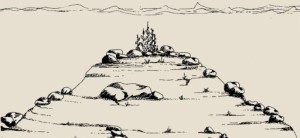Big pike are predators and also not pushovers. Being at the top of the food chain they can muscle their way into the prime real estate on any water system. Northern pike, especially big ones, inhabit the structures on a water system that best meet a variety of criteria, including access to food, shelter, ambushing opportunities, water temperature, and oxygen levels.
Prime areas that often meet these criteria for large pike after they’ve spawned in the shallows are points, humps and saddles. Here’s a refresher on these time-honored pike structures.
Points
Points are a piece of structure that juts out into deep water off of shore or an island. They range in shapes and sizes but ultimately points extend into and are surrounded by deeper water. The variation they provide compared to the uniform surrounding shoreline and underwater contours, along with fast access to deep water, make them attractive to pike.
Northern move on points to feed, whether on walleye, perch, bass, or any other species they can get their mouths on. Wind-blown points attract big pike as the turmoil created by waves often stimulates feeding activity as prey become disoriented. Pike are active all day, but morning and evening are particularly good times to try points. When choosing points consider that the larger the structure the more fish it’s likely to hold.
 Humps
Humps
A hump is an uprising in the bottom depth with a considerable area. They’re also often referred to as bars or sunken islands. The same fish-attraction structural qualities of points also make humps a common place to find northern. Mid-lake humps are particularly productive for trophy pike during summer and autumn. On large, deep lakes northern often inhabit cool, deep water where they’ll follow and feed on schools of whitefish and lake herring.
Humps often attract deep-water pike as both resting and foraging areas. Shallow humps, that peak around 10- to 15 feet often have weed growth, which will attract all sizes of pike. Deeper, rocky humps that top out around 20- to 35 feet appeal to big, deep-water fish.
 Saddles
Saddles
A saddle is best described as follows: Picture yourself holding a rubber band in two hands so it’s straight. Move your hands together and the band drops — there’s your saddle. Your thumbs and forefingers represent either humps or islands, which could vary in size and shape, and the bends in the band are the sloping, connected points that join these two land masses. Sometimes these slopes are relatively uniform, as in the rubber band example, while in other instances one side may extend farther or drop faster than the other.
In addition to the reasons listed above for points and humps, there are a few other benefits to saddles. The first is they tend to be fairly sizeable structures giving them the potential to hold multiple big fish. Add to this the fact that saddles contain a variety of different depths plus plenty of physical features all wrapped up in one interconnected formation, and it’s no wonder they’re a pike paradise and typically known as big fish spots.
Structure Details
When fishing points, humps and saddles, paying attention to the finer details in the layout of these areas will catch you more and bigger pike. You want to find additional features that will concentrate fish. These zones are often referred to as “the spot on the spot” and represent prime real estate for fish. Small fingers, which could be described as miniature points, and inside bends on any of these three spots have a tendency to attract fish and funnel their movements. Focusing on deep weed walls is wise as pike will hunt along these edges. Rock piles also attract fish.
The next time you’re pursuing a fishing map, keep points, humps and saddles in mind. These structures regularly hold quality northern pike throughout the year after fish have spawned. Fish them thoroughly and don’t be afraid to hit the same structure multiple times in a day to better your chances at intercepting a big pike feeding.
Follow our HUNTING BLOG
WEB RATES FISH HUNT CABINS PHOTOS
TESTIMONIALS BROCHURE HUNT BOOKLET



